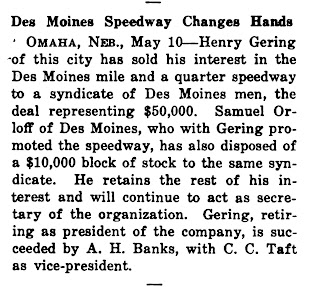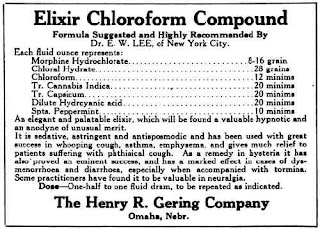I had planned to write something about a fascinating fellow named Eugene Konecky, a left-wing poet and journalist of 1930s Omaha, who had some interesting romantic affairs (is that enough of a teaser?), but instead I got distracted by a telephone call. A library patron wanted to know whether he remembered correctly that there used to be a bar called Ace’s at South 16
th and Williams, and he thought that before that it was called “Ace and Ann.” A quick Google search brought up the address, 1263 S. 16
th Street, and the fact that the building, described as “the old ‘Ace’s Bar’ building,” is, or rather was,
for sale, at a bargain price (it was sold last October for only $18,000). According to the Douglas County Tax Assessor’s office, it was built in 1887 as a bar/tavern, and never remodeled. The building includes a two-bedroom apartment on the second floor.

I admit, it’s not really one of those beautiful old buildings that preservationists will defend to the death, especially now that it has some really rude graffiti on the door (tactfully invisible in the assessor’s photo), and the neighborhood seems to be dying, but it led to some interesting historical byways.
First of all, it seems to have been a working-class neighborhood bar nearly continuously for over a hundred years, which is pretty neat. It was set squarely in what used to be called “Bohemian Town,” according to page 6 of the Reconnaissance Survey of Portions of South Central Omaha (a fantastic resource, also available in print form at Omaha Public Library; they did these surveys for many parts of the city). The Omaha city directory indicates that in 1889 Frank Swoboda had a combination saloon, grocery, and hay and feed store at that corner, obviously meeting every need any normal person might have—especially booze, since judging by the newspaper publication of yearly liquor licenses, in those days there seems to have been a saloon on every other corner. The true opium of the masses…? The 1909 Omaha Police Department Official Historical Souvenir (available in our Nebraska Reference section) has an ad for Frank Semerad's bar at that particular corner; and the 1910 census shows that Frank lived over the saloon with his wife, three children, a servant, and the saloon's bartender and porter. How cozy! All the adults were from Austrian Bohemia.
I didn’t look at every year between 1887 and now, but did note that Prohibition took its toll—in 1926, for example, the property was occupied by J.A. Kopecky Soft Drinks (shh, come around to the back….). And it was Frank Sloger Soft Drinks in 1932.
 |
| 4319 S. 27th St. |
Now, Ace and Ann! “Ace” was Walter Sempek, born in 1910 to Polish immigrants. The family lived for many years in “Little Poland” (
http://www.nebraskahistory.org/histpres/reports/omaha_south.pdf, p. 5) at 4319 S. 27
th St., in a two-bedroom house with 1.5 bathrooms, still standing. Built in 1895 (the swans are more recent), it is an example of the front-gable worker’s cottage that the
Reconnaissance Survey describes as typical of the era, and it seems to be holding up pretty well.
The interesting thing is how they all fit in—the 1930 census shows nine people living there: Joseph and Mary Sempek, their six children (Walter was the eldest), and—a lodger! Privacy, of course, had yet to be invented.
Walter, or Ace (this nickname appeared in his obituary—
Omaha World Herald, 16 Feb. 1978, A.M. edition, p. 50—and on his tombstone in the largely Polish
St. John’s Cemetery) worked in the Cudahy packing house, one of the four giant meatpacking plants in Omaha at the time, along with his sister Cecilia and many other people in the neighborhood.
In 1932, at the age of 21, he married 18-year-old Ann Luczinski, the daughter of Austrian-Polish immigrants, and as if 4319 S. 27th St. wasn’t already crowded enough, she moved in with Walter in his parents’ house. It probably wasn’t all that much of an adjustment, actually, because in her own home, a couple of miles away at 29th and Arbor (according to the 1930 census), she shared what was probably the usual worker’s two-bedroom house with her parents and seven siblings (her address no longer exists, so we can only guess).
Walter and Ann eventually moved into a house of their own, and after many years in the packing plant (Cudahy’s was followed by a stint at Nebraska Beef), Walter apparently scraped together enough to buy the bar at 1263 S. 16th St. The 1949 directory shows it as vacant, and there was no directory in 1950, but in 1951 the Ace and Ann Restaurant made its directory debut. Walter (Ace) and Ann apparently lived in the apartment over the bar, as so many bar-owners had done before them. (1520.5 square feet. Intimate.) They had at least five children (going by Walter’s 1978 obituary), though they would have been almost grown by the time their parents finally achieved the American dream: their own business.
Over the years the name varied—it was the Ace and Ann Restaurant, Ace and Ann’s Tavern, and Ace and Ann’s Bar at various moments in history, or at least in various city directories—but always Ace and Ann; they must have been a solid team. Then Ace died in 1978, and Ann followed him in 1985. By 1984 Ace’s brother Joe (who, incidentally, still lived back in the old neighborhood, barely a block from the house he grew up in) was running the bar (Omaha World Herald, 12 Feb. 1984); and by 1990 it had apparently left the family; Patti Albertson owned it (Omaha World Herald, 22 April 1990), and it was no longer Ace and Ann but Aces Only. Seems rather a snub to poor Ann… Things seemed to go downhill a bit from there, with the bar appearing in the paper mostly in connection with stabbings, thefts, and illegal video slot machine operations.
And now it is closed. That’s it, the life and death (perhaps) of an ordinary little neighborhood bar. Insofar as any place that encapsulates someone’s life story is ordinary.*
*Interestingly—if you’re a little nerdy, anyway—in colonial times “ordinary” was a common term for a tavern or saloon, especially in the south.





























